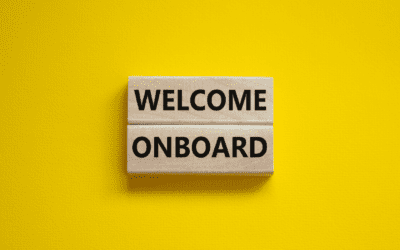Navigating the hellos and goodbyes in the workplace is a familiar dance for every company. We’ve felt those same flutters of excitement and twinges of bittersweet farewells ourselves.
But we all know that allowing even a hint of chaos during these transitions isn’t in the playbook — especially when studies show that a well-oiled onboarding process can skyrocket new hire retention by an impressive 82%.
Our checklist is your trusty companion, crafted to help you orchestrate seamless introductions and fond farewells that let your team members know they are truly appreciated from their first steps through the door until their final curtain call.
Let’s make each journey within your company as smooth as can be.
Key Takeaways
- Onboarding is like welcoming a new family member. A good onboarding process includes preboarding with welcome packages, detailed training, and ongoing support. It helps new hires feel at home and work well quickly.
- Offboarding is the end of an employee’s time with us. We must communicate their departure, transfer knowledge, get back company things, give final paychecks, and do exit interviews or surveys.
- Making mistakes in offboarding can hurt our reputation and cause legal problems. We avoid this by being thorough in exit interviews, serious about security, personal in our approach, organized in the process, and clear about timelines.
- Using technology makes onboarding and offboarding easier. With digital checklists and HR systems, we don’t miss steps or lose information. Tech helps us save time and money while keeping things correct.
- Both onboarding and offboarding show how much we value the people who work for us. Doing these processes right means happier team members who join or leave our company feeling good about their experience.
Understanding Onboarding and Offboarding
Understanding Onboarding and Offboarding goes beyond just welcoming a new hire or bidding farewell to a departing employee—it’s about crafting the entire journey from entry to exit.
It’s an art that, when perfected, can significantly enhance workplace culture and retention. Let’s dive into what each term truly encompasses and why they’re pivotal in the employee lifecycle.
Definition of Onboarding
Onboarding is like welcoming someone into a new family. We ensure our new team members feel right at home from day one. It’s more than just showing them to their desk or giving them a quick office tour.
Onboarding is about helping them blend into our company culture and values. We provide resources, on-the-job training, and support they need to hit the ground running.
Think of onboarding as setting up a friend in a new city. You wouldn’t just give them a map; you’d show them around, introduce them to people, and share insider tips—that’s what we do for our newcomers.
It helps us ensure everyone can do their best work and stick with us for the long haul.

Definition of Offboarding
Offboarding marks the end of an employee’s journey with our company. It happens after someone decides to leave, whether they resign, retire, or are involuntarily terminated. This process is not just about saying goodbye; it wraps up their professional relationship with us in a structured way.
We ensure all loose ends are tied up—like recovering company assets and revoking systems access.
This is our chance to part on good terms no matter why they leave. We learn what we can improve by conducting exit interviews and getting feedback. A smooth offboarding ensures the person leaves feeling respected and maintains a positive view of our employer brand.
And let’s not forget—it helps protect us from legal issues and keeps everything organized for whoever comes next!
The Importance of Effective Onboarding and Offboarding

We know that first impressions last, which is why effective onboarding matters. It’s like welcoming a new family member; we want them to feel part of the team from day one. Good onboarding helps new hires learn about company values, understand their role, and start contributing faster.
This leads to better job satisfaction and higher chances they’ll stick around for the long haul.
Now, let’s talk offboarding. It’s not just a goodbye ritual—it’s much more than that. A smooth offboarding process protects our knowledge base by ensuring valuable information stays with us even when employees move on.
It also leaves the door open for boomerang employees who might return in the future with additional skills and experience. And let’s not forget risk management—we must ensure all company assets are returned, and access to systems is revoked securely.
Both processes are key pieces of workforce management that keep everything running smoothly and maintain our organization’s reputation as a great workplace.
Steps to Create an Effective Onboarding Checklist
Let’s dive into crafting a robust onboarding checklist that lays the groundwork for a smooth and engaging introduction to your organization. We’re talking about setting the stage for success from day one—think of it as building a bridge between excitement and productivity for your new hires.
Now, follow along as we unfold the essential steps to ensure every box is ticked, paving the way for an effective transition into your team!
Preboarding Stage
Let’s make the preboarding stage count. It sets the tone for a new employee’s journey with us and prepares them for success from day one.
- Send a warm welcome email or package to share our excitement about their new role.
- Include important documents like the employee handbook, tax forms, and benefit enrollment information.
- Before starting, ensure they understand our company’s vision, mission, and values.
- Set up their email accounts, workstations, and access to necessary systems.
- Assign a buddy or mentor who will help them navigate the early days.
- Arrange for their first-day schedule, including any orientation or training sessions.
- Give a preview of ongoing professional development opportunities within the company.
- Encourage them to ask questions and express any concerns they might have.
Training Stage
Training is where we get down to business. It’s the heart of onboarding, where new team members learn how to succeed in their roles.
- Schedule an official welcome session. Have a leadership team member introduce the company’s mission and values.
- Assign a mentor or buddy. This person can answer questions and help the new hire feel at home.
- Provide a detailed job description. Make sure it includes clear expectations and success metrics.
- Organize essential training sessions. Cover everything from safety protocols to company-specific software.
- Set up role-specific learning objectives. Outline what must be learned within the first 30, 60, and 90 days on the job.
- Offer on-the-job training for hands-on experience. This helps new hires understand their daily tasks better.
- Promote open communication. Encourage them to ask questions to clarify doubts without hesitation.
- Plan regular check-ins with supervisors or HR. Discuss progress and any issues, and provide constructive feedback.
- Give access to online resources and tools like Google Workspace. These can support ongoing learning efforts.
- Collect employee feedback through an online survey or informal chats. Use insights gained for personal growth plans.
Follow-Through Stage
We’re not done yet after the training stage. The follow-through stage is crucial to sealing the deal on a successful onboarding process. Here’s how we make sure our new hires are fully integrated and comfortable in their new roles:
- Set up regular check-ins: We schedule meetings with new employees to address questions and ensure they feel confident in their work.
- Gather feedback: Asking for input from our new team members helps us see what’s working and what needs tweaking.
- Assign a buddy or mentor: Pairing newcomers with a seasoned employee can boost their confidence and help them feel like part of the team faster.
- Monitor progress: Keeping an eye on how new hires are doing lets us catch any issues early and provide support where needed.
- Celebrate milestones: Recognizing achievements, big or small, can greatly enhance employee morale and engagement.
- Review goals and expectations: We revisit the initial objectives set during preboarding to ensure we’re all on the same page.
- Offer additional training resources: If they want more learning opportunities, we’ve got plenty of tools and courses at their disposal.
- Encourage team interaction: We promote activities that help forge connections within the team, boosting organizational culture.
Steps to Create an Effective Offboarding Checklist
Crafting an effective offboarding checklist is much like setting the stage for a graceful exit – it’s all about ensuring every detail is accounted for, from communicating the departure to tying up loose ends; dive into our table and see how each step can transform a potentially bumpy ride into a smooth transition.
Communicate the Departure
Let’s make sure everyone is on the same page when an employee decides to leave. We start by sharing the news of their departure with key people in the organization. This isn’t just about saying goodbye; it’s a vital step to maintain smooth operations and morale.
We gather essential details like the person’s name, role, and last working day.
It’s our job to handle these transitions with care. We reach out personally to those affected by the change and support them through the next steps. Think of it as setting up dominoes; we line everything up so that when one piece moves, the rest follow without crashing down.
Facilitate Knowledge Transfer
After sharing news of the departure, we move to a critical step: facilitating knowledge transfer. This means working closely with the departing employee to pass on important information and duties.
We aim for a smooth transition that keeps our team’s operations running without a hitch.
We sit down together and map out all the key tasks and responsibilities. Our goal is to make sure nothing falls through the cracks. We document processes, share useful contacts, and detail ongoing projects.
By doing this, we equip other team members with everything they need to take over seamlessly. It’s about preserving know-how and maintaining our high standards—even during times of change.
Recover Company Assets
Handing over knowledge is just the start. We must also get back what belongs to the company. Every piece of equipment needs to come home, from laptops and phones to keycards and ID badges.
It’s our job to keep track of all these items. We create a list that shows everything an employee receives.
We make sure nothing gets missed during offboarding. Our checklist includes every asset we need back. If something is missing, we follow up quickly. This step protects our information and keeps our property safe.
We’ve learned that clear instructions help employees return items on time.
Let’s not forget about digital access, either! Revoking system access is crucial for security. It takes care of this immediately to guard against data breaches or misuse.
Next on the list is making sure everyone gets their final pay.
Issue Final Pay
Let’s ensure our team members leave with everything squared away, including their final paycheck. It’s part of showing respect and closing the chapter on good terms. We gather e-signatures for all the exit paperwork first – it streamlines the process and keeps things clear.
Then we issue that last pay promptly. Whether it’s salary, unpaid vacation days, or any owed bonuses, we calculate it to the penny.
We’re committed to a smooth offboarding experience, just like SweetProcess champions in their checklist, and paying out what is due helps prevent any legal hang-ups down the road. Our folks worked hard for us; now it’s our turn to ensure they leave without worrying about their final compensation.
That’s how we maintain trust and positivity even when saying goodbye.
Conduct an Exit Survey or Interview
We always make sure to conduct an exit survey or interview when someone is leaving our team. It’s a crucial step that helps us understand why they are moving on. Their feedback gives us valuable information about their experience with our organization.
We learn what we did well and where we can improve. This knowledge is a goldmine for making changes that can boost employee retention.
During these interviews, we ask direct but respectful questions. We want to know about the departing employee’s journey from start to finish—what motivated them, what frustrated them, and how they feel about their time with us.
We handle this process carefully to ensure a positive experience for both sides and keep doors open for future reconnections or referrals. After all, every goodbye holds the key to better hellos down the line.
Common Mistakes to Avoid During Offboarding
We’ve all heard about the significance of making good first impressions, but let’s not forget the lasting impact of final impressions. As we part ways with employees, our offboarding process speaks volumes about our company culture and operational integrity. We must get this right, not just for the departing team member but for our organization’s ongoing morale and reputation.
Now, we outline some common offboarding pitfalls that we strive to avoid. Remember that these aren’t just bumps in the road; they’re potential roadblocks to a smooth transition and can affect both parties down the line.
| Mistake | Consequences | Better Approach |
|---|---|---|
| Not being thorough enough during the exit interview | Missed opportunities to learn and grow from feedback | Prepare structured questions and ensure a comfortable setting for honest dialogue |
| Skimping over security measures | Risks to data and access integrity | Comprehensive checklists to revoke access and secure all sensitive information |
| Being too impersonal | Leaving the employee with a negative view of the company culture | Personalize the process to show appreciation for the employee’s contributions |
| Failing to conduct the exit interview thoroughly | Inability to capture valuable insights | Dedicate time and attention to glean comprehensive feedback |
| Not taking security measures seriously | Potential breaches and loss of trust | Invest in a standardized procedure that reflects our company’s professionalism. |
| Failing to recognize the value of a well-organized offboarding process | Damaged employer brand and potential legal issues | Train all relevant staff on offboarding procedures to maintain high standards. |
| Making secure offboarding abrupt | Creating unnecessary stress and potential oversight | Plan and communicate timelines to ensure a seamless transition |
| Not providing entry-level training for the offboarding process | Inconsistent execution and potential errors | Train all relevant staff on offboarding procedures to maintain high standards |
Meticulous attention to detail and personal touch makes a world of difference in offboarding. As we refine our procedures, we remain committed to upholding the highest standards, ensuring a respectful and secure transition for every team member heading out to new horizons.
Utilizing Technology in the Onboarding and Offboarding Process
Technology has become our best friend in guiding new hires and managing departures. With paperless forms, we cut down on clutter and make everything faster. Systems like HRIS help us keep track of everyone’s progress from day one.
They even remind us when it’s time for performance reviews or to update resumes.
We also use tech tools to ensure no step is missed during offboarding. Our checklists go digital, meaning we can tick off tasks like revoking systems access or scheduling exit interviews with a click.
Employees can hand over their responsibilities smoothly through online knowledge transfer platforms, making transitions less stressful for everyone involved. Tech keeps things clear, quick, and compliant, helping us safeguard the company against any potential legal issues while maintaining strong connections with departing staff through alumni groups.
This smart use of technology saves time and money—two things we always want more of!
Conclusion
We’ve covered the essentials for a smooth onboarding and offboarding experience. If we get it right, we set the stage for long-term success and show respect to those who are leaving.
Let’s not forget – our checklists ensure nothing slips through the cracks, from welcoming new team members to bidding farewell with dignity. It’s all about keeping things clear and consistent, making transitions in or out as seamless as possible.
Remember, by investing time into these processes now, we save headaches later!
Frequently Asked Questions
What should an onboarding checklist include for success?
For a smooth start, your onboarding checklist should have systems access setup, introductions to key team members, and training in tools like CRMs or ERPs. It’s the foundation for employee engagement and quickly getting them up to speed.
Why is revoking system access important in offboarding?
Revoking system access during offboarding keeps data secure – it’s best practice! Don’t forget this step; leaving doors open could lead to serious security risks and legal liability.
How do HRIS platforms fit into the employee life cycle?
HRIS platforms are central hubs for all things human resources – they track an employee from their very first day until their last. They’re packed with organizational insights that guide decisions throughout life.
Can effective offboarding prevent retaliation?
Yes indeed! A well-handled offboarding process—through clear communication and finalizing paperwork properly—can leave employees feeling respected, reducing chances of retaliation or bad-mouthing on social media.
Should employers offer COBRA insurance in an offboarding checklist?
Absolutely! If your organization falls under COBRA guidelines—check those details—you must provide info about insurance premiums continuation as part of your checklist.
Are there benefits to promoting job vacancies through LinkedIn during offboarding?
You bet! Sharing vacancies on LinkedIn helps attract talent — think potential employee referrals — which can fill gaps faster and boost return on investment when someone leaves.



0 Comments